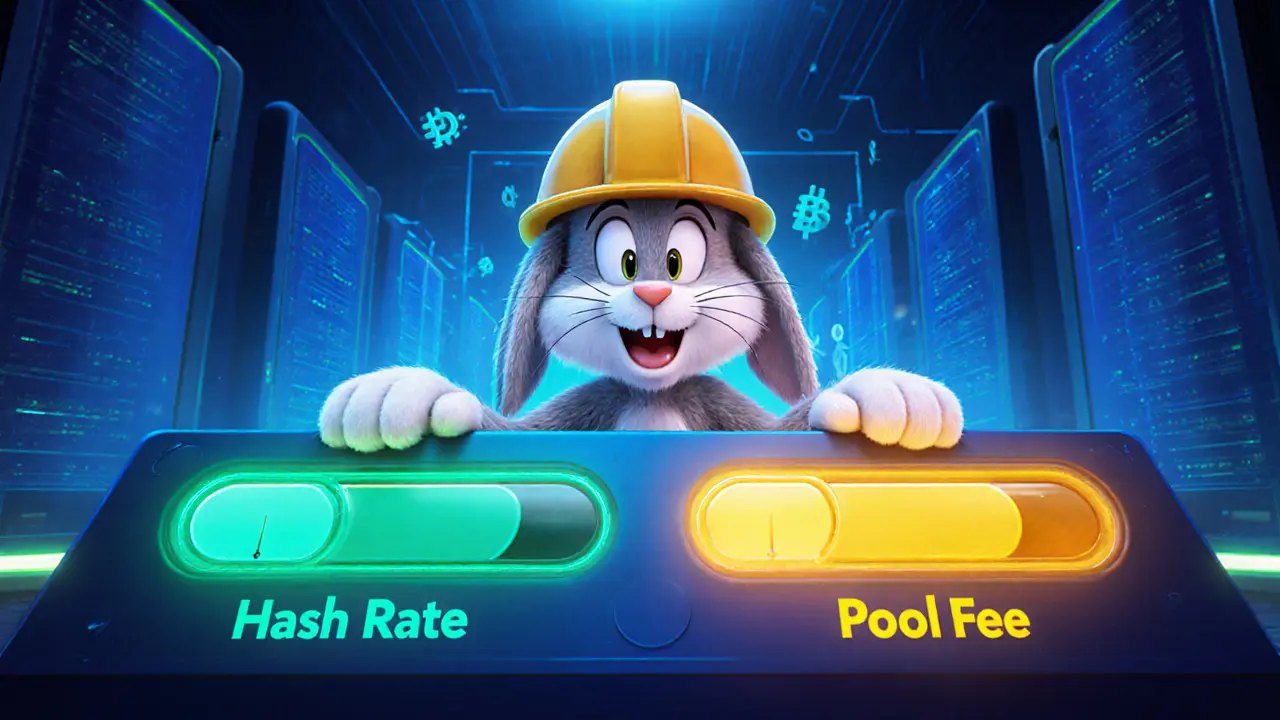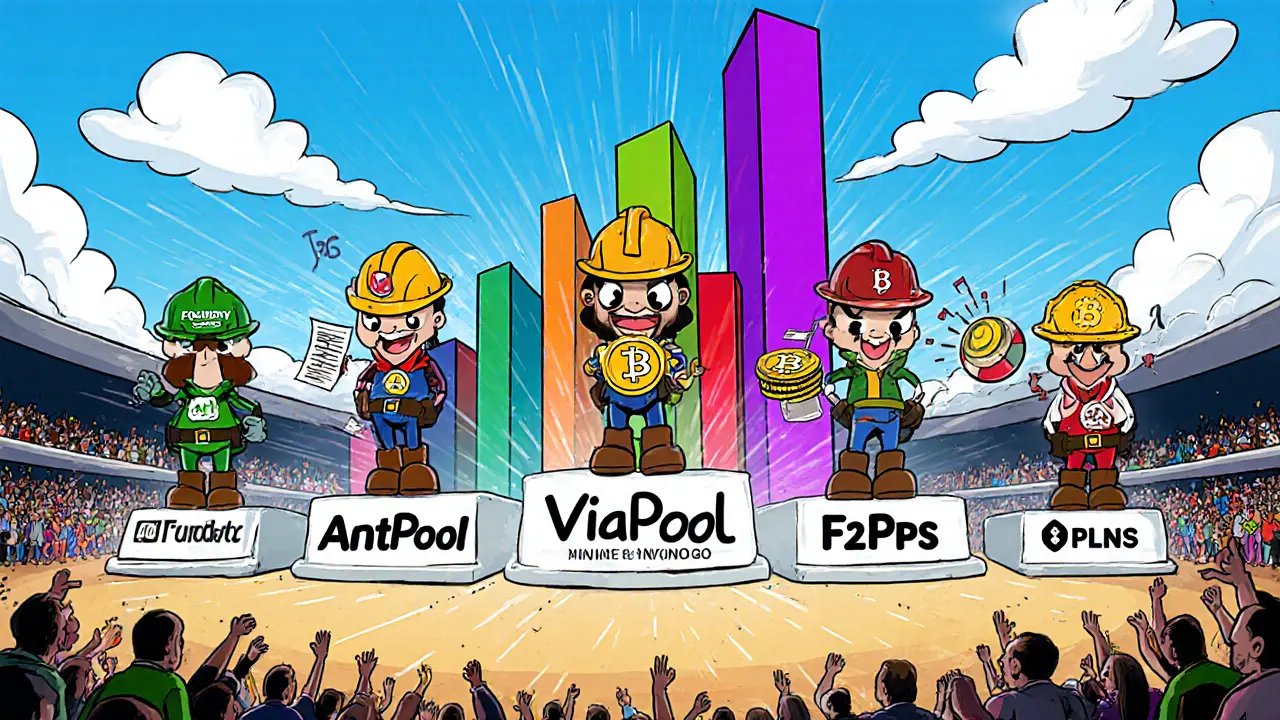
Mining Pool Comparison Tool
Recommended Pools Based on Your Criteria
How to Use This Tool
Adjust the sliders to filter pools based on your requirements. Pools are ranked by hash rate and then by fee to show the best matches for your setup.
Click on a pool card to view detailed information.
Choosing the right mining pool can make the difference between a steady paycheck and months of dead‑end revenue. This guide walks you through every factor that matters, shows how to compare real‑world pools, and gives a step‑by‑step setup checklist so you can start earning faster.
What a Mining Pool Actually Is
Mining pool is a group of miners who combine their hash power to solve blocks together and split the rewards based on each participant’s contribution. By pooling resources, individual miners avoid the massive variance of solo mining and get paid out more regularly.
Key Metrics You Must Evaluate
- Hash rate represents the total computational power a pool contributes to the network. Higher hash rates mean the pool finds blocks more often, which translates to steadier payouts.
- Pool fee is the percentage taken from each reward to cover the pool’s operating costs. Most pools charge between 1% and 4%.
- Payout structure dictates how and when you get paid. The three most common methods are Full Pay Per Share (FPPS), Pay Per Share Plus (PPS+), and Pay Per Last N Shares (PPLNS).
- Uptime measures how often the pool’s servers stay online. A 99%+ uptime is the industry baseline; any downtime directly eats into your hash power.
- Server location affects latency. The closer the pool’s entry node to your rig, the faster shares are submitted.
- Minimum payout threshold is the smallest amount the pool will send to your wallet. Lower thresholds improve cash flow for small‑scale miners.
- Pool size / market share shows how much of the total network hash the pool controls. Larger pools give frequent payouts, smaller pools can offer bigger individual slices when they win.
Fee and Payout Structures - When to Pick Which
Fees are easy to compare, but the payout model often decides which pool fits your risk profile.
- FPPS (Full Pay Per Share): Every share you submit is paid instantly at a fixed rate that already includes transaction fees. Expect the highest fee (2‑3%) but the most predictable income.
- PPS+ (Pay Per Share Plus): Similar to FPPS but the pool adds transaction fees on top of the block reward. Fees hover around 1‑2%, offering a middle ground between stability and earnings.
- PPLNS (Pay Per Last N Shares): No fixed payment per share. The pool records the last N shares (often 10‑100% of a block) and distributes the whole block reward proportionally. Fees are usually the lowest (≈1%), but payouts can swing wildly.
For miners who need a regular cash flow-say to cover electricity bills-FPPS or PPS+ are safer. If you can tolerate variance and chase higher net profit, PPLNS often wins.
Top Pools by 2025 Performance
| Pool | Hash Rate (EH/s) | Market Share | Fee | Payout Types | Uptime |
|---|---|---|---|---|---|
| Foundry USA | 256.3 | 26.6% | 1.1% | FPPS, PPS+ | 99.7% |
| AntPool | 178.4 | 17.96% | 1.3% | PPS+, PPLNS | 99.4% |
| ViaBTC | 113.7 | 13.69% | 1.2% | FPPS, PPS+, PPLNS | 99.6% |
| F2Pool | 102.9 | 10.68% | 1.4% | PPS+, PPLNS | 99.5% |
| Binance Pool | 68.2 | 7.0% | 0.99% | FPFS, PPS+ | 99.8% |
These numbers are from Koinly’s 2025 analysis and give you a quick snapshot of who controls most of the Bitcoin network’s hash power. Large pools dominate, but the fee spread and payout options still vary enough to matter.

How to Test a Pool Before Committing
Don’t lock your rigs into a single pool forever. Run a short‑term test with the following checklist:
- Pick a pool with a free or low‑fee tier.
- Configure one ASIC (or GPU) to point at the pool’s primary server.
- Monitor share acceptance rate for 24‑48hours. If the pool rejects many shares, its latency or difficulty settings are off.
- Verify the payout after the first block is found. Compare the actual net reward against the pool’s published fee and payout model.
- Check the pool’s dashboard for real‑time hash‑rate reporting and payout history.
Swap to a second pool and repeat. The pool that consistently delivers the highest net profit while keeping your rigs online is the winner.
Setting Up Your Miner - Step‑by‑Step
Below is a generic configuration flow. Specific pools will provide exact URLs and port numbers, but the logic stays the same.
- Log into your pool’s website and locate the Mining Settings page.
- Copy the server address (e.g.,
stratum+tcp://us1.pool.example.com:3333). - In your miner’s firmware or mining software, paste the address.
- For ASICs, this is usually done via the device’s web UI under Pool Configuration.
- For GPU miners, edit the
config.txtor launch command:miner.exe -o stratum+tcp://...
- Create a worker name (e.g.,
rig01) and a strong password. - Enter your payout wallet address exactly as the pool expects (most pools support BTC, LTC, etc.).
- Save the settings and restart the miner.
- Watch the pool’s dashboard for the first share submission-usually appears within a few seconds.
- If you see “stale” or “invalid” shares, double‑check your difficulty settings and latency.
After a few hours you should see a small balance appear in the pool’s web UI. If not, verify firewall rules and that your ISP isn’t throttling port 3333.
When to Switch Pools
Even the best pool can become sub‑optimal as market conditions shift. Consider moving when:
- Fee structures change upward by more than 0.5%.
- Uptime drops below 98% for a month.
- New pools launch with modern ASIC fleets that beat the average hash‑rate per miner.
- Your hardware upgrades push you into a higher hash‑rate tier where a smaller, low‑latency pool might now be more profitable.
Keep a spreadsheet of each pool’s net earnings per terahash per day (TH/s·day). When the gap widens beyond 5‑10%, it’s time to test a new candidate.
Risks Beyond the Numbers
Technical and financial risks often hide behind the metrics we’ve covered.
- Centralization risk: A handful of pools control >40% of Bitcoin’s hash power. Concentration can affect network security and may invite regulatory scrutiny.
- Server attacks: DDoS attacks can knock a pool offline for hours. Choose pools with multi‑region failover.
- Hidden fees: Some pools add withdrawal fees or charge extra for low‑balance payouts. Review the fee schedule carefully.
- Pool shutdown: Rare, but a pool that ceases operations can freeze unwithdrawn balances. Keep a backup pool ready.
Quick Decision Checklist
- Does the pool’s fee fit your profit margin?
- Is the payout structure aligned with your cash‑flow needs?
- Is the hash rate large enough for frequent block finds?
- Does the pool publish uptime of 99% or higher?
- Are server locations geographically close to you?
- Is the minimum payout threshold low enough for your scale?
- Do community reviews voice confidence in the pool’s transparency?
If you can answer “yes” to most of these, you’ve probably found a solid fit.

Frequently Asked Questions
What is the difference between FPPS and PPLNS?
FPPS pays you for every share you submit at a fixed rate, so earnings are steady and predictable. PPLNS only distributes rewards after the pool finds a block, using the last N shares as the pool’s payout pool, which can lead to higher payouts but also periods of zero income.
How much does latency really matter?
Even a 50ms delay can cause a few percent of shares to be rejected during high‑difficulty periods. Choosing a pool with a server within the same continent as your rig can shave off that latency and improve overall profitability.
Can I join more than one pool at the same time?
Yes. Many miners run a primary pool for the bulk of their hash and a secondary, low‑latency pool as a backup. Just remember that each pool will track its own payout threshold and fee schedule.
What’s a safe minimum fee to look for?
A fee around 1%‑1.2% is common among reputable pools offering FPPS or PPS+. Anything lower than 0.8% often means the pool is subsidizing the service, which can disappear without notice.
How often should I reevaluate my pool choice?
At least once every three months, or whenever a major fee change, uptime drop, or new pool launch is announced. Treat pool selection like a regular maintenance task for your rig.





